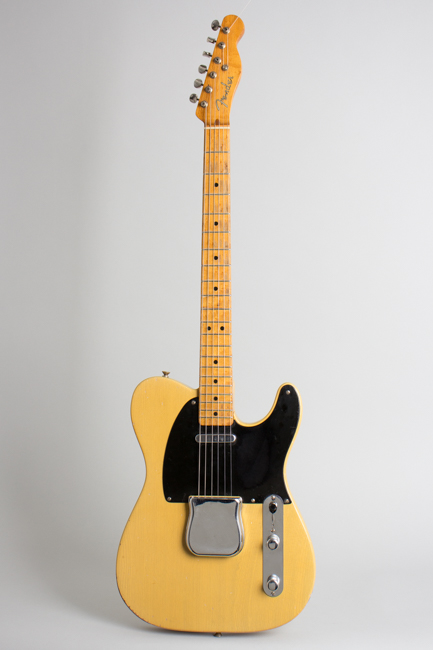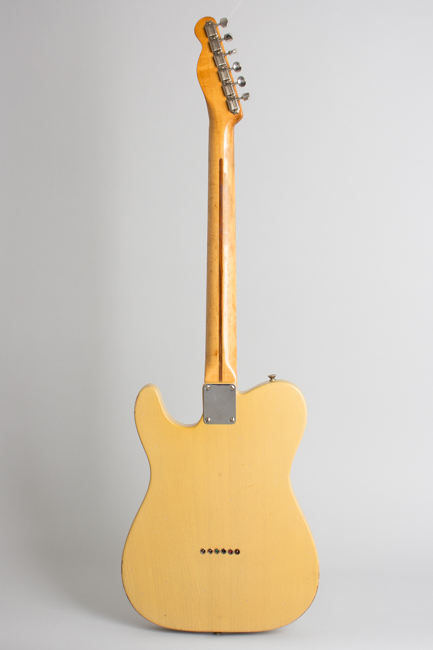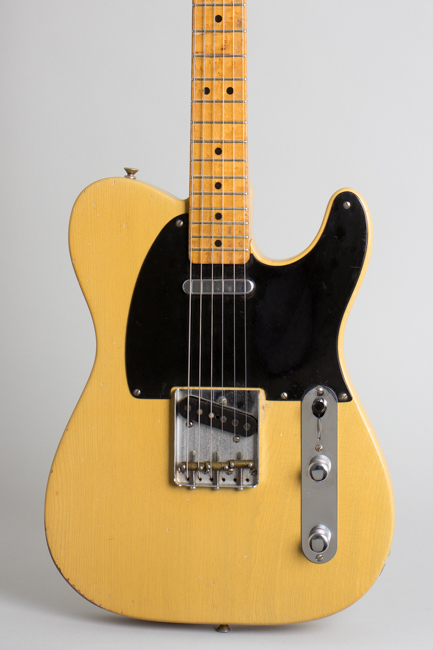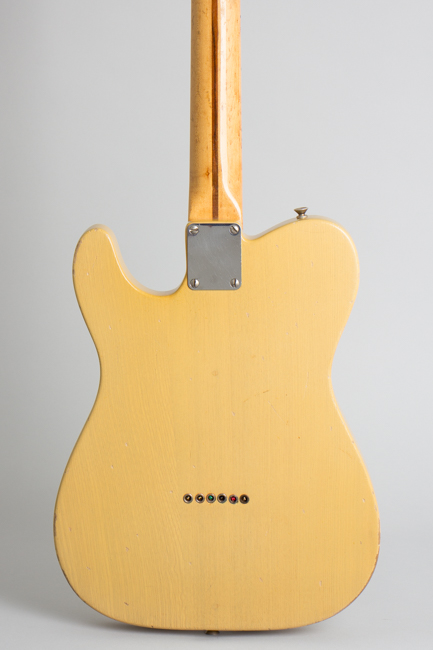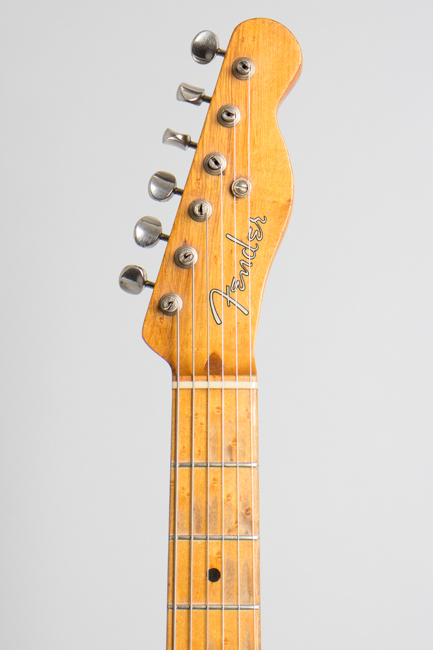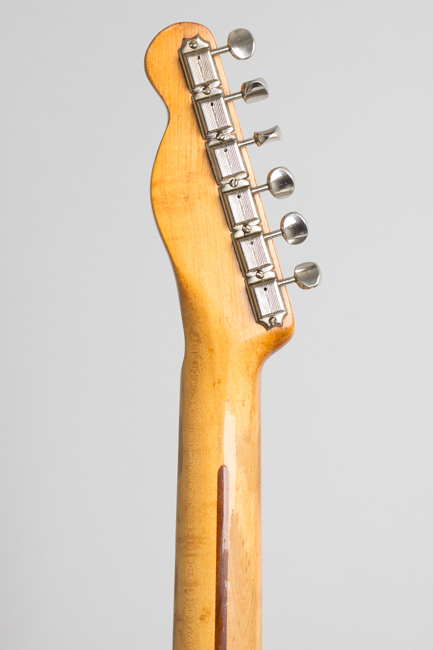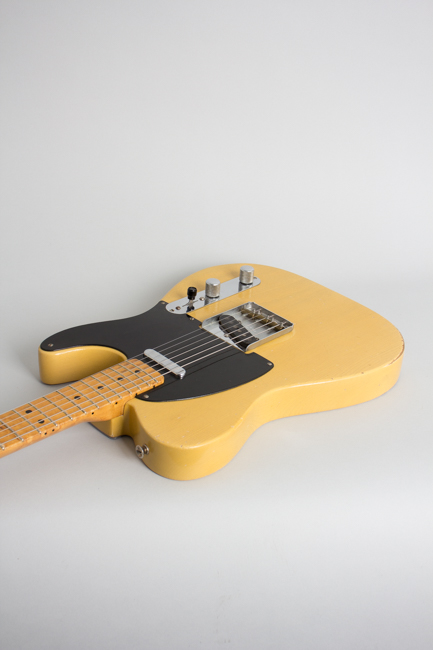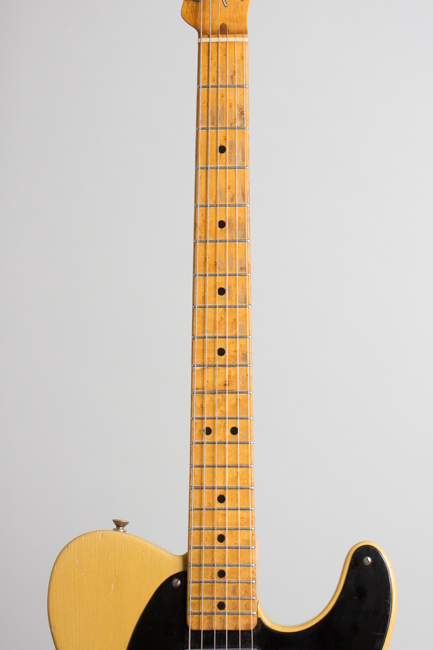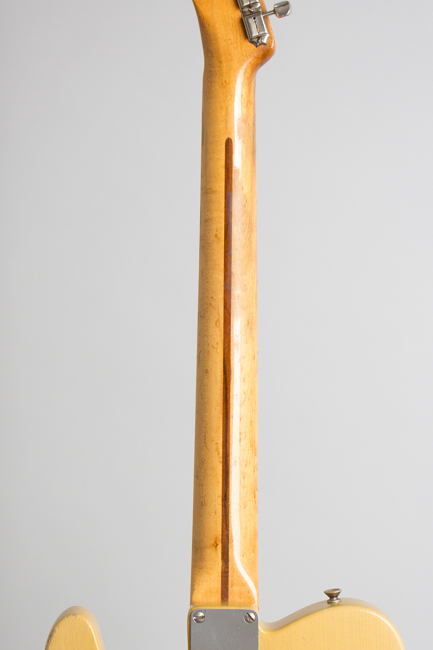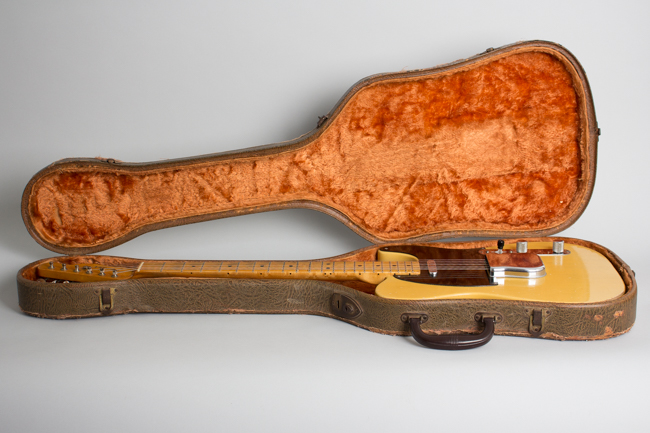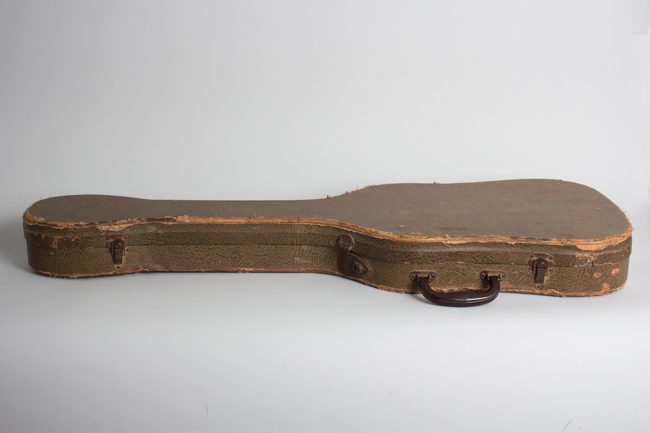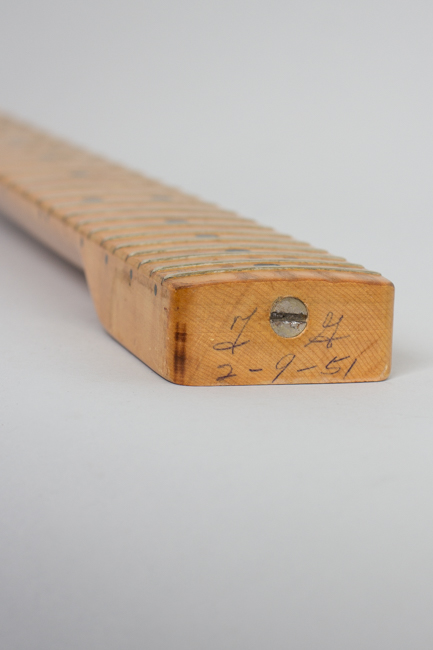Fender Nocaster Solid Body Electric Guitar (1951)
This item has been sold.
Item # 11712
Prices subject to change without notice.
Fender Nocaster Model Solid Body Electric Guitar (1951), made in Fullerton, California, serial # 1664, Blonde lacquer re- finish, ash body, maple neck, original brown hard shell case.
This is one of the coolest early Fenders we have seen; a super rare and historic "Blackguard", one of the first clipped decal "No-Casters" (the collectors' name, not Fender's!). It was made in February 1951 just as the "Broadcaster" name was discontinued before "Telecaster" replaced it. It is beautifully restored with a body-only refinish by Tele maven Carson Hess, one of the few working today who does this just right. The body features the seldom seen (and whimsically named) "donut rout" under the pickguard, a very rare transitional feature. The 1950 Broadcaster has no rout between the pickups; shortly after this guitar was made the familiar oblong rout was adopted. This seldom seen round "donut rout" became a subject of much online interest when first brought to light some years ago; only a handful exist with this feature.
This guitar is original except for the body finish, and a nearly exact match to a "No-Caster" featured in Nacho Banos' recent book "The Pinecaster"; the two have contiguous serial numbers and show the same interesting combination of early features. The body has an unusual (for Fender) straight grain pattern indicating it was cut from quarter-sawn ash; this is most visible in the neck pocket. This is specific to guitars built in the Jan-Feb. 1951 time frame, likely all made from the same stash of ash.
The serial number 1664 is stamped into the bridgeplate; while higher than might be expected for early 1951 this is correct; Fender never ran the numbers in sequence. The penciled neck date is 2-9-51 with the initials of Taddeo Gomez on either side of the truss rod, another idiosyncratic feature of this period. The body carries a neatly penciled date mark of 2-5-51 in the neck cavity, with the initials "TK". The potentiometer date codes are soldered over, but the pots are the correct originals.
The "Broadcaster" name was quickly discontinued at Fender after they received a telegram from Gretsch on the 21st of February 1951 claiming that trademark. This guitar, already in progress at the time would have been one of the first to be sent out with the "nameless" clipped decal now reading just "Fender" on the headstock face.
This guitar has seen an eventful life since it was shipped out in 1951, apparently refinished at least twice since. As early Fender finishes were not particularly hard-wearing, this is not too unusual. The neck finish and all parts remain original, except the electronics were long ago re-wired to the "modern" Telecaster switching scheme. As originally set up, there was an unusual deep bass/pickup blend setting discontinued in early 1952. It is now set up with a standard 2-pickup, 3-way selector and standard tone control with a later (1960-70s) cap.
The very comfortable neck has a nice, round profile slimmer than some we have had. At 7.66 Lbs (with the bridge cover on) this is a medium light and very handy guitar. The screws are all flathead types correct for 1951 including the truss rod adjustor. The Kluson deluxe tuners are the early "closed shell" version, and even small parts like the jack cup and strap buttons have small variations from later versions. Fenders were hand-made in a small Quonset hut in early 1951; this guitar retains the look and feel of the 1950 Broadcaster, changes primarily being the "No-Caster" headstock decal and the eccentric "donut" rout. The one-piece maple neck, blonde-finished ash body, lacquered black fiber pickguard, brass bridge saddles, and of course the early pickups with a sound for the ages carry through the Blackguard years.
Fenders from 1950-51 have been highly sought for decades now. Many of the fine details of the instrument continued to gradually evolve but this is where it all began, the first flowering of the Fender guitar. This is simply a fantastic instrument; it really rings even not plugged in, and the lead pickup is pure twang heaven.
Overall length is 38 3/4 in. (98.4 cm.), 12 5/8 in. (32.1 cm.) wide at lower bout, and 1 3/4 in. (4.4 cm.) in depth, measured at side of rim. Scale length is 25 1/2 in. (648 mm.). Width of nut is 1 5/8 in. (41 mm.)., 7.66 lbs.
This is a beautifully restored guitar, and even so still more original than many seven-decade survivors. The body lost its fragile original finish long ago; the instrument resurfaced with a natural refinish, and appears to have been painted a reddish hue at some point before. It recently received a perfect accurate early-style refinish by Carson Hess, with a light relic treatment to match the neck. The neck finish appears completely original, a bit uneven as they were in this very early period with some typical wear down to the wood on the back. The maple fingerboard has play wear mostly along the treble side and some "strum wear" at the body end. The headstock shows some light checking and the original decal is very well preserved.
The lacquered black pickguard is original and shows some typical wear, notably a rubbed-down spot below the strings. It shows traces the round "paint can" mark on the underside where the pieces were rested on top of cans to be sprayed. The original bridge, saddles and screws are cleaner than many; the guitar appears to have been played mostly with the bridge cover on long ago. The early pattern Kluson tuners are also quite clean and still working well. Small parts including the strap buttons, jack cup and screws are original as well; nothing on the guitar appears replaced.
As noted the guitar was re-wired to the "modern" 3-way switch layout with a tone control. This has been left as is; few players would prefer the original "blend knob" wiring once it has been changed, though it could be restored if desired. The pickups and electronic components (pots, switch and wire) remain original except the original tone circuit is no longer in place, and a later vintage cap added to the tone pot. The cloth pickup leads show neat splices done during the re-finishing (at least one of them). The original early switch is a bit loose in operation but works fine. The early Broadcaster pattern knobs and switch tip remain original.
The guitar refretted some time back with period correct small wire, which has since been dressed down. The bone nut is later as well. This is really a great sounding instrument, the epitome of the early Fender tonal aesthetic. It lives in the rare original brown shaped pasteboard case, a serious rarity in itself now 70+ years on. While not 100% original, this is still a very historic guitar with the finest possible restoration to its original appearance. Restored to Excellent Condition.
This is one of the coolest early Fenders we have seen; a super rare and historic "Blackguard", one of the first clipped decal "No-Casters" (the collectors' name, not Fender's!). It was made in February 1951 just as the "Broadcaster" name was discontinued before "Telecaster" replaced it. It is beautifully restored with a body-only refinish by Tele maven Carson Hess, one of the few working today who does this just right. The body features the seldom seen (and whimsically named) "donut rout" under the pickguard, a very rare transitional feature. The 1950 Broadcaster has no rout between the pickups; shortly after this guitar was made the familiar oblong rout was adopted. This seldom seen round "donut rout" became a subject of much online interest when first brought to light some years ago; only a handful exist with this feature.
This guitar is original except for the body finish, and a nearly exact match to a "No-Caster" featured in Nacho Banos' recent book "The Pinecaster"; the two have contiguous serial numbers and show the same interesting combination of early features. The body has an unusual (for Fender) straight grain pattern indicating it was cut from quarter-sawn ash; this is most visible in the neck pocket. This is specific to guitars built in the Jan-Feb. 1951 time frame, likely all made from the same stash of ash.
The serial number 1664 is stamped into the bridgeplate; while higher than might be expected for early 1951 this is correct; Fender never ran the numbers in sequence. The penciled neck date is 2-9-51 with the initials of Taddeo Gomez on either side of the truss rod, another idiosyncratic feature of this period. The body carries a neatly penciled date mark of 2-5-51 in the neck cavity, with the initials "TK". The potentiometer date codes are soldered over, but the pots are the correct originals.
The "Broadcaster" name was quickly discontinued at Fender after they received a telegram from Gretsch on the 21st of February 1951 claiming that trademark. This guitar, already in progress at the time would have been one of the first to be sent out with the "nameless" clipped decal now reading just "Fender" on the headstock face.
This guitar has seen an eventful life since it was shipped out in 1951, apparently refinished at least twice since. As early Fender finishes were not particularly hard-wearing, this is not too unusual. The neck finish and all parts remain original, except the electronics were long ago re-wired to the "modern" Telecaster switching scheme. As originally set up, there was an unusual deep bass/pickup blend setting discontinued in early 1952. It is now set up with a standard 2-pickup, 3-way selector and standard tone control with a later (1960-70s) cap.
The very comfortable neck has a nice, round profile slimmer than some we have had. At 7.66 Lbs (with the bridge cover on) this is a medium light and very handy guitar. The screws are all flathead types correct for 1951 including the truss rod adjustor. The Kluson deluxe tuners are the early "closed shell" version, and even small parts like the jack cup and strap buttons have small variations from later versions. Fenders were hand-made in a small Quonset hut in early 1951; this guitar retains the look and feel of the 1950 Broadcaster, changes primarily being the "No-Caster" headstock decal and the eccentric "donut" rout. The one-piece maple neck, blonde-finished ash body, lacquered black fiber pickguard, brass bridge saddles, and of course the early pickups with a sound for the ages carry through the Blackguard years.
Fenders from 1950-51 have been highly sought for decades now. Many of the fine details of the instrument continued to gradually evolve but this is where it all began, the first flowering of the Fender guitar. This is simply a fantastic instrument; it really rings even not plugged in, and the lead pickup is pure twang heaven.
Overall length is 38 3/4 in. (98.4 cm.), 12 5/8 in. (32.1 cm.) wide at lower bout, and 1 3/4 in. (4.4 cm.) in depth, measured at side of rim. Scale length is 25 1/2 in. (648 mm.). Width of nut is 1 5/8 in. (41 mm.)., 7.66 lbs.
This is a beautifully restored guitar, and even so still more original than many seven-decade survivors. The body lost its fragile original finish long ago; the instrument resurfaced with a natural refinish, and appears to have been painted a reddish hue at some point before. It recently received a perfect accurate early-style refinish by Carson Hess, with a light relic treatment to match the neck. The neck finish appears completely original, a bit uneven as they were in this very early period with some typical wear down to the wood on the back. The maple fingerboard has play wear mostly along the treble side and some "strum wear" at the body end. The headstock shows some light checking and the original decal is very well preserved.
The lacquered black pickguard is original and shows some typical wear, notably a rubbed-down spot below the strings. It shows traces the round "paint can" mark on the underside where the pieces were rested on top of cans to be sprayed. The original bridge, saddles and screws are cleaner than many; the guitar appears to have been played mostly with the bridge cover on long ago. The early pattern Kluson tuners are also quite clean and still working well. Small parts including the strap buttons, jack cup and screws are original as well; nothing on the guitar appears replaced.
As noted the guitar was re-wired to the "modern" 3-way switch layout with a tone control. This has been left as is; few players would prefer the original "blend knob" wiring once it has been changed, though it could be restored if desired. The pickups and electronic components (pots, switch and wire) remain original except the original tone circuit is no longer in place, and a later vintage cap added to the tone pot. The cloth pickup leads show neat splices done during the re-finishing (at least one of them). The original early switch is a bit loose in operation but works fine. The early Broadcaster pattern knobs and switch tip remain original.
The guitar refretted some time back with period correct small wire, which has since been dressed down. The bone nut is later as well. This is really a great sounding instrument, the epitome of the early Fender tonal aesthetic. It lives in the rare original brown shaped pasteboard case, a serious rarity in itself now 70+ years on. While not 100% original, this is still a very historic guitar with the finest possible restoration to its original appearance. Restored to Excellent Condition.
